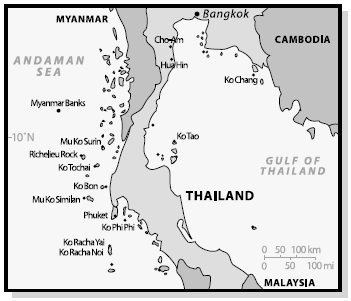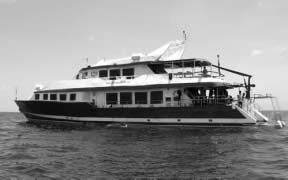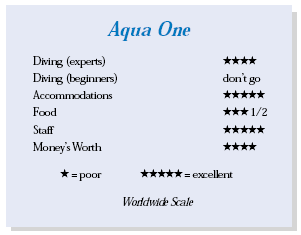Aqua One: ThailandContents of this Issue: U.S. State Department Warnings A Word from Cayman Diving Lodge Readers Report on Equipment Insurance Cozumel Taxi Mafia Holds Tourists Hostage New Jersey Court Deals Blow to Liability Waiver Lost at Sea: Coming to a Multiplex Near You Editorial Office: Ben Davison Publisher and Editor Undercurrent 3020 Bridgeway, Suite 102 Sausalito, CA 94965 diving in the Adaman Sea from the June, 2004 issue of Undercurrent
Dear Fellow Diver, Several years ago, during the winter whale shark migration in the Andaman Sea, I joined the Pelagian liveaboard out of Phuket, an island in Southern Thailand questionably called "the pearl of the sea." Thai dive boats once guaranteed whale shark sightings or they'd refund your money. By the late '90s, those guarantees disappeared as fewer whale sharks were sighted, to some extent because they are being slaughtered for shark fin soup. The day we circled their favorite haunt, Richelieu Rock, I saw none. This March I gave Andaman another try. The conditions seemed perfect. Consistent 83-degree aqua blue water combined with the greenish bloom of plankton in the usual whale shark seamount hangouts. How could those behemoths deny me? I landed in Phuket(poo-ket'), where the main town is Patong Beach, a somewhat seedy beach town offering sexual and massage services with "happy endings" and lots of cheap merchandise knock-offs. From there, it was a 45-minute shuttle to the 115-foot Aqua One, built as a dive boat in 1999. Cruise director Johnny Gallick, a Connecticut expat, welcomed us aboard and briefed us. He introduced our two Indonesian divemasters, Ali, a "ghost pipefish expert" and Nus, a "frog fish specialist"; Tia, who covered the deck and salon; and two female servers. Proud of his Italian heritage, Johnny is a self-described "sea gypsy," who joined the Aqua One four years ago. During the offseason, he designs his own line of clothing and surfboards, called "Bonehead." I joined eight other divers who travel the world
together diving exotic destinations. The "Chicken Divers,"
as they call themselves, brought their mascot, a rubber
chicken (decked out with a SARS protection mask), which
eventually was rigged to the masthead to flutter with
Buddhist prayer flags. Bang! The religious tradition of lighting firecrackers announced Aqua One's departure, and we headed north to Mu Ko Similan National Park -- a five-hour boat ride -- cruising at a speedy 18 knots. The nine granite islands are lush with tropical jungle and sprinkled with white sandy beaches. We took a check-out dive at Moonlight Bay, where a damsel fish harassed an octopus on a coral bommie and I followed a rare golden whiptail ray down to 90 feet. There were cowries, nudibranch, scorpion and lion fish, schools of small jack, and a hawksbill turtle. Pointing with a chopstick, Nus showed us several ghost pipefish camouflaged in soft coral. Ali pointed to two octopuses making boom boom, as the Thai say. The mooring line broke during a safety stop, a warning that divers here must be skilled enough to hang at 15 feet without support. Boulders the size of an apartment building dominated the underwater landscape at Similan Island #2. Two 6-foot leopard sharks lazed in the sand at 85 feet. Several blue crowns of thorn were inflated like basket stars. Pairs of longfin and phantom banner fish darted around the rocks. As the current picked up, viz dropped from 100 to 75 feet. Finning behind the huge rocks, I avoided the current, but one of AO's two Zodiacs (they had ladders) would pick us up whenever we needed a hand. Johnny treated us as responsible, experienced divers -- no crew-checked air gauges, return to the boat whenever, no formal buddy pairing. We could be diving maniacs or responsible free spirits. Still, he did ask that we carry safety sausages to protect us from being run over by other boats, which were common above.
Ko Bon, just outside the Similan Islands, has been designated a marine park for only a few years. Damage from dynamite fishing is evident between patches of healthy coral. Here, mantas circled us curiously. Clownfish darted from dozens of anemones. I saw black common octopus, moray and sharp-nosed eels, many species of nudibranch, and a lone reef shark. Continuing north, we dived Koh Bon and Koh Tach, a seamount where a manta greeted me. There was a plateau with a batfish cleaning station, and whitesegmented worms nibbled on barrel sponges. Chevron barracuda, jack, and trevally swam in the swirling currents. A bright yellow day boat dropped a couple of dozen divers on the mount, roaring its engine above us. The AO was designed with comfort in mind. In the salon, there were four tables for dining, and forward a couch with video, DVD, and stereo. Upstairs, there was a library with a comfortable couch, working table for cameras, and a charging station; on the outside sundeck were more camera tables with an air hose. Eight roomy, airconditioned cabins (with individual controls) house 16 passengers. Each cabin is configured with queen or twin beds (a wood partition offers some privacy), a head, and shower. They provide flipflops, a robe, and a hair dryer. The four deluxe cabins on the salon deck have full-size windows in both the bedroom and shower. The lower deck has four less desirable cabins (rumored to have a cockroach or two), where the occupants could hear the nonstop drone of the engines and generator; these rooms were not as well ventilated and had portholes instead of full-size windows. Each diver was assigned a gear basket and an aluminum 80, reliably filled to 3,200 psi, with 32 percent Nitrox if desired. Tia, always smiling, was there to help with a BC strap or pull off your wetsuit. The dozen crew were gracious and accommodating, and though they spoke little English all excelled at their jobs. They taped a number on each camera for identification (five of us were using Ikelite digital housings) and checked the Nitrox percentage. Twin stairs with five easy fin-walking steps led to the water (on some dives we rode in dinghies). There were two large tanks for camera rinse and two for gear. Leaving Koh Tachai, we motored north to Richilieu, unfortunately not part of the Mu Ko Similan National Park, so when the dive boats leave each day, fishermen lower their nets. Macro was the big draw during our 2 1/2 days. Shrimp - - red and white Christmas cleaners and banded coral, cricket-like ridgedback and Harlequin shrimp -- were everywhere. A lone cuttlefish hovered over a nest of eggs. A stunning, rare red pencil anemone appeared like a stain on the ocean floor. A school of squid pulsated in the current. A pair of yellow seahorses stood out in the rocks. A hawksbill turtle seemed unruffled by photographers. Schools of Chevron barracuda circled. In one area, clams spawned, shooting mini-geysers into the water. Large spotted potato cod, being cleaned by wrasse, lazed on rocks. As familiar as I became with the seamont, I always found something new. Leaving Richilieu and heading south, we stopped at an unnamed wreck where puffers were so large they had remoras attached. Then we continued motoring 12 hours and 25 miles southwest of Phuket to 5 Islands, where a night dive yielded decorator crabs and a leaf scorpion fish. Early the next morning, we stopped at Koh Bida Nok near Phi Phi, where red limestone islands have been the backdrop for James Bond films, with plenty of critters, a leopard shark basking on the sand, and swim-throughs filled with glassy sweepers. At one site, a potentially deadly black banded sea krait slithered by, one of three on the trip. Cool as it was, I was still looking for whale sharks. Crowds are a problem almost everywhere, thanks to more than 50 dive operators in Phuket. I counted 13 dive boats one morning. In one swim-through, a beginning diver fighting the surge kicked me. A psycho dayboat divemaster leading two divers at Richelieu got agitated because the Chicken Divers were photographing some harlequin shrimp. He threatened us with a gesture like he was cutting his throat, flipped off the divers, and then tried to kick Ali. Once, as we hung for a safety stop on a common mooring line to which another boat happened to be tied, their guide gave us a finger shaking. It wasn't unusual to see a pack of divers following a divemaster in a single formation, bypassing many interesting critters. Johnny heard over the radio that divers had sighted a whale shark at Red and Purple Rocks, so we left #5 island and headed farther south, arriving at daybreak. Jumping off the dive platform, I descended into the plankton-rich, 25-foot visibility water of Purple Rock. Schools of spadefish and barracuda hovered. The anemone-covered seamount had lots of critters including a green mantis shrimp and a gorgeous green and blue juvenile emperor angelfish. And no whale shark. But wait! Back on the boat, we heard a whale shark had been sighted at nearby Red Rock, so back we piled into the Zodiac. No whale sharks there, either. Returning to Purple Rock, the plankton was soupy, but I watched 12-foot majestic black mantas circling. The current pulled us away from the boat, and one diver who chased a manta wasn't found until after sunset. When he flashed his camera strobe to signal, he was a good half-mile from the boat. The incident did suggest safety shortcomings. With divers in the water, both chase boats were tied to the Aqua One's stern, and there was no provision for divers to log in or out for dives, a serious shortcoming. Each morning at 7 a.m., an ornate Thai bell tinkled, but most divers were
awake, coffee from fresh ground beans in hand, tackling a light breakfast of yogurt
and toast or cereal, and ready to dive. Johnny gave theatrical dive briefings with
a hand-drawn topographical map, and all of us were in the water before 8 a.m. Upon
return from the first dive, our full breakfast would be on the table -- fresh
fruit, eggs, bacon, sausage, and pancakes. If I lingered underwater, my breakfast
would be cold. Filtered water was served, and an espresso coffee maker was popular,
as was the green tea. Meals were primarily Thai cuisine, which could have
been a tad spicier, with delicious flavors of garlic, ginger, cilantro, and lemon
grass. Dessert was frequently a cake, fresh fruit, or ice cream. There was no authoritative 24- hour "no-fly" rule. We each made our own determinations based on our individual computer readings, and on the final day made two or three dives accordingly. At Koh Yuhn, two hours south of Phuket, I stayed shallow (50 feet) doing muck dives. In the sandy 25-foot visibility, I found unbelievable critters like small speckled frogfish, velvetfish, red seahorses, sea moths, leather jackets, column anemones with transparent shrimp, sea pens, and a small flounder and octopus. Even the Thai fish guide nudibranch cover girl Thecacera -- the spotted, tiger-striped, twoappendage (a pair on both its rhinophores and gills) -- posed for us. Before I had peeled off my skin after the last dive, Tia, who had just handed me a hot towel, had my gear rinsed in clean water and drying for the trip home. No whale sharks, a few mantas and sharks, not a lot of big fish, plenty of tropicals and macro. Though the variety of diving and camaraderie, unique critters, and a superb and eager staff made this trip special. -- G.S.
|

I want to get all the stories! Tell me how I can become an Undercurrent Online Member and get online access to all the articles of Undercurrent as well as thousands of first hand reports on dive operations world-wide
| Home | Online Members Area | My Account |
Login
|
Join
|
| Travel Index |
Dive Resort & Liveaboard Reviews
|
Featured Reports
|
Recent
Issues
|
Back Issues
|
|
Dive Gear
Index
|
Health/Safety Index
|
Environment & Misc.
Index
|
Seasonal Planner
|
Blogs
|
Free Articles
|
Book Picks
|
News
|
|
Special Offers
|
RSS
|
FAQ
|
About Us
|
Contact Us
|
Links
|
3020 Bridgeway, Ste 102, Sausalito, Ca 94965
All rights reserved.

 Chicken's predecessor had disappeared in a bait ball during a
shark feed in Papua New Guinea.
Two young, friendly, twentysomething
Austrians rounded out
the passenger manifest.
Chicken's predecessor had disappeared in a bait ball during a
shark feed in Papua New Guinea.
Two young, friendly, twentysomething
Austrians rounded out
the passenger manifest.  At #5 island (that's how they name them) I saw an amazing rainbow of corals,
red pencil anemones, and blue and purple gorgonians overwhelmed by massive staghorn
and lettuce coral. Lionfish hung
under ledges. Triggerfish dug
nests in the sand. A pair of
Oriental sweetlips disappeared
into a school of shimmering silversides.
At Snapper Alley,
there were two ghost pipefish
camouflaged in soft coral, a red
long-snout pipefish hiding among
red rods, and a motionless stonefish.
Hanging under ledges were
spotfin and black white-lined
lionfish. At night, I saw spider
and porcelain crabs, harlequin
shrimp, nesting parrotfish, and
ghost pipefish.
At #5 island (that's how they name them) I saw an amazing rainbow of corals,
red pencil anemones, and blue and purple gorgonians overwhelmed by massive staghorn
and lettuce coral. Lionfish hung
under ledges. Triggerfish dug
nests in the sand. A pair of
Oriental sweetlips disappeared
into a school of shimmering silversides.
At Snapper Alley,
there were two ghost pipefish
camouflaged in soft coral, a red
long-snout pipefish hiding among
red rods, and a motionless stonefish.
Hanging under ledges were
spotfin and black white-lined
lionfish. At night, I saw spider
and porcelain crabs, harlequin
shrimp, nesting parrotfish, and
ghost pipefish.  There was always
a noodle dish and some fish, chicken, or vegetarian alternative, but no special
presentation. Sometimes the food was boring -- spaghetti was served three days in
a row -- and though generally tasty, it wasn't imaginative. Most meals were served buffet-style including a mixed-grill,
sundeck barbecue. There was the
"drink, don't dive" policy, but the
only alcohol on the boat was complimentary
beer and one bottle of Thai rum
(which didn't last long). This was a
five-dive-a-day kinda group.
There was always
a noodle dish and some fish, chicken, or vegetarian alternative, but no special
presentation. Sometimes the food was boring -- spaghetti was served three days in
a row -- and though generally tasty, it wasn't imaginative. Most meals were served buffet-style including a mixed-grill,
sundeck barbecue. There was the
"drink, don't dive" policy, but the
only alcohol on the boat was complimentary
beer and one bottle of Thai rum
(which didn't last long). This was a
five-dive-a-day kinda group. Diver's Compass: The 10-day trip costs $3,075; add $16/day for
Nitrox. ... The Aqua One offers Andaman trips between November
and May; cruises to Indonesian waters were planned June to
October, but a reticent American clientele, afraid of terrorism,
has put that destination on hold. ... Depending on season and
stops, round-trip fare runs $950-$1600. ... After a long 18-
hour, nonstop, Singapore Airline flight, I decompressed in
Singapore two days at the Sea Pearl hotel in Phuket before joining
up with the group. ... Arrive a day early and take a tour of a rubber tree
forest, a silkworm and silk factory, and a cashew plant. ... Art Travers of
Poseidon Ventures organized the trip. ... Aqua One offers Scubapro dive rental
gear. E-6 processing was done daily, but most shot digital and brought computers
loaded with Adobe PhotoShop to download images. ... The crew was certified in the
use of DAN-approved oxygen. Phuket has a deco chamber. ... Lycra was necessary to
protect against hydra and the occasional jelly. ...
Diver's Compass: The 10-day trip costs $3,075; add $16/day for
Nitrox. ... The Aqua One offers Andaman trips between November
and May; cruises to Indonesian waters were planned June to
October, but a reticent American clientele, afraid of terrorism,
has put that destination on hold. ... Depending on season and
stops, round-trip fare runs $950-$1600. ... After a long 18-
hour, nonstop, Singapore Airline flight, I decompressed in
Singapore two days at the Sea Pearl hotel in Phuket before joining
up with the group. ... Arrive a day early and take a tour of a rubber tree
forest, a silkworm and silk factory, and a cashew plant. ... Art Travers of
Poseidon Ventures organized the trip. ... Aqua One offers Scubapro dive rental
gear. E-6 processing was done daily, but most shot digital and brought computers
loaded with Adobe PhotoShop to download images. ... The crew was certified in the
use of DAN-approved oxygen. Phuket has a deco chamber. ... Lycra was necessary to
protect against hydra and the occasional jelly. ... 